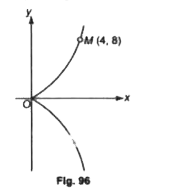Compute the arc length of the curve y= ln cos x between the points with the abscissas x=0,x=π4
The correct Answer is:ln tan3π8
To compute the arc length of the curve y=ln(cosx) between the points x=0 and x=π4, we will use the formula for arc length given by:
L=∫ba√1+(dydx)2dx
Step 1: Find dydx
Given y=ln(cosx), we need to differentiate it with respect to x:
dydx=ddx(ln(cosx))=1cosx⋅ddx(cosx)=1cosx⋅(−sinx)=−tanx
Step 2: Substitute dydx into the arc length formula
Now we substitute dydx into the arc length formula:
L=∫π40√1+(−tanx)2dx
This simplifies to:
L=∫π40√1+tan2xdx
Step 3: Use the identity 1+tan2x=sec2x
Using the trigonometric identity 1+tan2x=sec2x:
L=∫π40√sec2xdx=∫π40secxdx
Step 4: Compute the integral of secx
The integral of secx can be computed as follows:
∫secxdx=ln|secx+tanx|+C
Thus, we have:
L=(ln|secx+tanx|)π40
Step 5: Evaluate the definite integral
Now we evaluate the limits:
1. At x=π4:
sec(π4)=√2,tan(π4)=1
Therefore,
sec(π4)+tan(π4)=√2+1
2. At x=0:
sec(0)=1,tan(0)=0
Therefore,
sec(0)+tan(0)=1+0=1
Putting it all together:
L=ln(√2+1)−ln(1)=ln(√2+1)
Final Answer
Thus, the arc length of the curve y=ln(cosx) between x=0 and x=π4 is:
L=ln(√2+1)
sec(π4)=√2,tan(π4)=1
Therefore,
sec(π4)+tan(π4)=√2+1
sec(0)=1,tan(0)=0
Therefore,
sec(0)+tan(0)=1+0=1
Topper's Solved these Questions
- APPLICATIONS OF THE DEFINITE INTEGRALBOOK - IA MARONCHAPTER - APPLICATIONS OF THE DEFINITE INTEGRALEXERCISE - The Arc Length of a Curve Represented Parametrically
4 Videos
- APPLICATIONS OF THE DEFINITE INTEGRALBOOK - IA MARONCHAPTER - APPLICATIONS OF THE DEFINITE INTEGRALEXERCISE - The Arc Length of a Curve in Polar Coordinates
7 Videos
- APPLICATIONS OF THE DEFINITE INTEGRALBOOK - IA MARONCHAPTER - APPLICATIONS OF THE DEFINITE INTEGRALEXERCISE - Computing the Volume of Solid
10 Videos
- APPLICATION OF DIFFERENTIAL CALCULUS TO INVESTIGATION OF FUNCTIONSBOOK - IA MARONCHAPTER - APPLICATION OF DIFFERENTIAL CALCULUS TO INVESTIGATION OF FUNCTIONSEXERCISE - ADDITIONAL PROBLEMS
9 Videos
- BASIC CLASSES OF INTEGRABLE FUNCTIONS BOOK - IA MARONCHAPTER - BASIC CLASSES OF INTEGRABLE FUNCTIONS EXERCISE - 5.8 INTEGRATION OF OTHER TRANSCENDENTAL FUNCTIONS
5 Videos
Similar Questions
Knowledge Check
The normal to the curve y=x2−x+1 drawn at the points with the abscissa x1=0,x2=−1 and x3=52
Aare parallel to each otherBare pair wise perpendicularCare concurrentDare not concurrentThe area bounded by the curves y = cos x and y = sin x between the ordinates x = 0 and x=3π2, is
A4√2+1B4√2−1C4√2+2D4√2−2The area bounded by the curves y = cos x and y = sin x between the ordinates x = 0 and x=3π2, is
A(4√2−2) sq unitsB(4√2+2) sq unitsC(4√2−1) sq unitsD(4√2+1) sq units
Find the area bounded by the curve y=cosx between x=0andx=2π
View SolutionThe area bounded by the curves y=cosx and y=sinx between the ordinates x=0 and x=3π2 is
View SolutionThe length of the normal to the curve y=acosh(xa) at any point varies as
View SolutionEquation of a tangent to the curve ycotx=y3tanx at the point where the abscissa is π4 is (a) 4x+2y= π+2 (b) 4x−2y=π+2 (c) x=0 (d) y=0
View SolutionCompute the length of the arc of the semicubical parabola y2=x3 between the points (0, 0) and (4, 8)

View Solution
